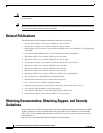
CHAPTER
1-1
Cisco IOS Software Configuration Guide for Cisco Aironet Access Points
OL-29225-01
1
Overview
Cisco Aironet Access Points (hereafter called access points) provide a secure, affordable, and
easy-to-use wireless LAN solution that combines mobility and flexibility with the enterprise-class
features required by networking professionals. With a management system based on Cisco IOS software,
Cisco Aironet access points are Wi-Fi certified, 802.11a-compliant, 802.11b-compliant, and
802.11g-compliant wireless LAN transceivers.
Note The 802.11n standard has not been ratified. Therefore, references to 802.11n throughout this document
refer to 802.11n Draft 2.0.
An access point serves as the connection point between wireless and wired networks or as the center
point of a stand-alone wireless network. In large installations, wireless users within the radio range of
an access point can roam throughout a facility while maintaining seamless, uninterrupted access to the
network.
You can configure and monitor the wireless device using the command-line interface (CLI), the
browser-based management system, or Simple Network Management Protocol (SNMP).
Each access point platform contains one, two, or three radios:
• The 1040 series access point has dual-band (2.4 GHz and 5 GHz), integrated 802.11n radios and
integrated antennas.
• The 1100 series access point uses a single, 802.11b, 2.4-GHz mini-PCI radio that can be upgraded
to an 802.11g, 2.4-GHz radio.
• The 1130 series access point has integrated 802.11g and 802.11a radios and antennas.
• The 1140 series access point has integrated antennas for its pre-802.11n radios operating on the 2.4-
or 5-GHz frequency bands.
• The 1200 series access point can contain two radios: a 2.4-GHz radio in an internal mini-PCI slot
and a 5-GHz radio module in an external, modified cardbus slot. The 1200 series access point
supports one radio of each type, but it does not support two 2.4-GHz or two 5-GHz radios.
• The 1230 series access point is pre-configured to include both an 802.11g and an 802.11a radio. It
has antenna connectors for externally attached antennas for both radios.
• The 1240 series access point uses two externally connected antennas for each band instead of
built-in antennas.
• The 1250 series access point uses three external connected antennas for its pre-802.11n radios
operating on the 2.4- or 5-GHz frequency bands.
• The 1260 series access point uses three external connected antennas for its pre-802.11n radios
operating on the 2.4- or 5-GHz frequency bands.


















